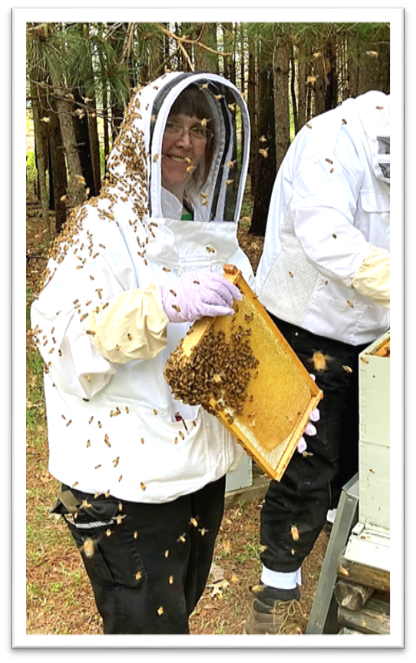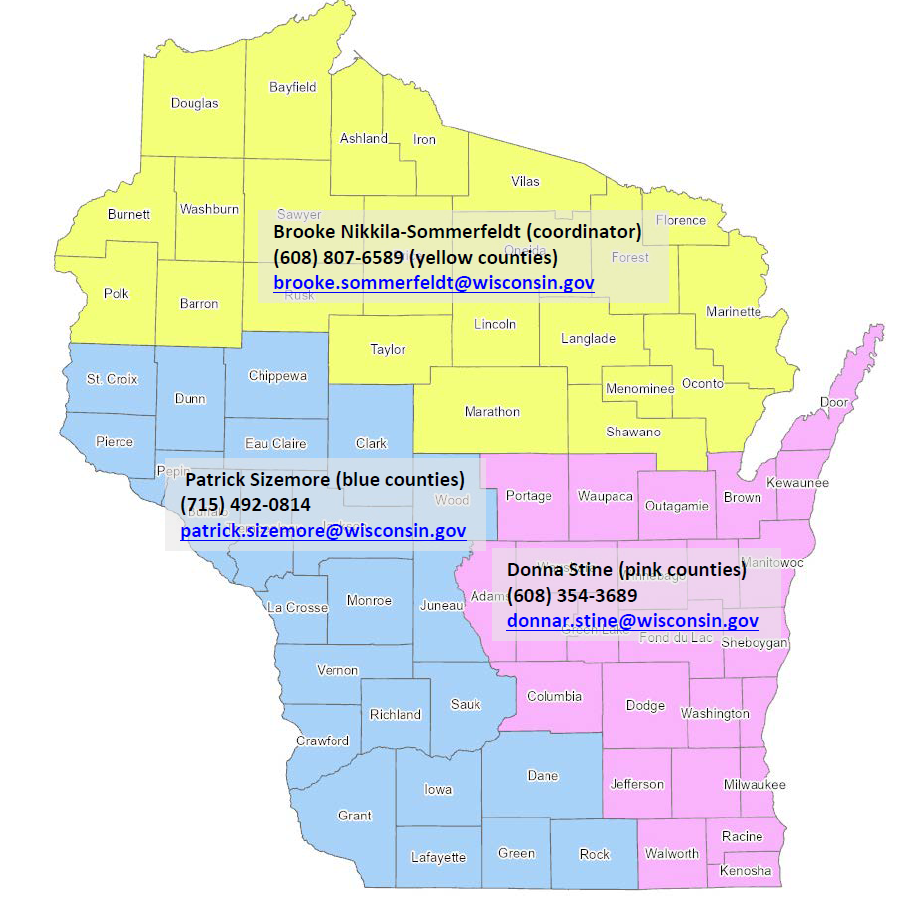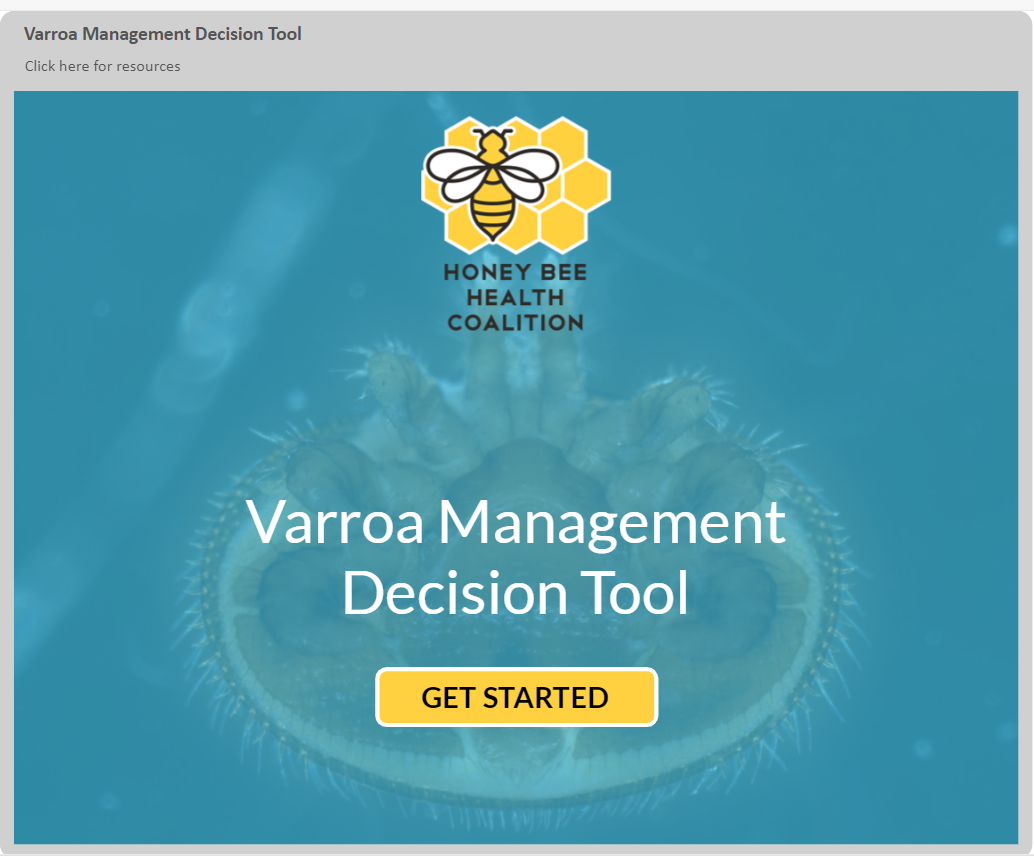
This is my last season as your apiary inspector. My husband and I are going full time RV-ing this winter and we hope to spend next summer in the Pacific Northwest.
I’m so thankful for all the people I’ve gotten to know as an apiary inspector over the last four summers. This has been the most fun and rewarding experience of my life. I wanted to thank everyone in the beekeeping world for being so kind and welcoming. I have learned so much and enjoyed sharing that knowledge with anyone willing to listen.
I’m excited about our new state apiarist and look forward to the direction she will be taking the apiary program. Thank you, one and all!
Sincerely,
Donna Stine
|
 If you're a migratory beekeeper in need of a Certificate of Apiary Inspection required to move your honey bees from Wisconsin to another state (e.g., for crop pollination), please contact us at DATCPapiary@wisconsin.gov to request an inspection with us before the end of October. After the inspection, the State Apiarist will provide you with an invoice (if applicable) and issue your Certificate(s) of Apiary Inspection once all fees are paid and data are evaluated. A DATCP apiary inspection is free, but each apiary certificate costs $50. Many states require certification to import honey bee colonies. If you are moving honey bees or regulated honey bee materials (e.g., beekeeping byproducts or beekeeping equipment) into another state, verify the destination state's requirements with their local apiary inspection service. For migratory inspections, colonies must be accessible in the yard and not yet loaded on the truck.
After overwintering your bees in another state, please remember to fill out a Honey Bee Import Report and send a copy of your most recent inspection (from up to 12 months prior, from Wisconsin or from inspection in another state) to DATCPapiary@wisconsin.gov before returning to Wisconsin with your bees.
For more information, check out our Moving Bees Into Wisconsin factsheet.
 Varroxsan Photo by Vita Bee
One of the fastest-moving invasive pests in the US is the spotted lanternfly (Lycorma delicatula) (SLF). SLF is a type of planthopper native to Asia. First detected in the US in Pennsylvania in 2014, it has since spread to at least 17 eastern and midwestern states, including Illinois, Indiana, and Michigan. SLF weakens plants by sucking large volumes of sap from over 70 plant species. Some of its favorite plants to feed on include tree-of-heaven, grapevines, hops, apple, roses, maple, walnut, willow, and poplar. SLF moves long distances when adults or nymphs hitchhike to new areas on firewood, nursery stock, rail cars, vehicles, shipping containers, bricks, stone, and other materials moved by humans. SLF females also lay egg masses (each containing up to 50 eggs) on vehicles and other outside items, spreading the insect to new areas to start new infestations. SLF egg masses are one to two inches long and resemble gray putty at first, before becoming hardened and cracked as the season goes on. Eggs hatch in late spring and early summer.
Once hatched, the wingless black nymphs (juveniles) with white spots emerge and begin feeding. They start developing into later stage nymphs with the addition of red coloring to their black bodies with white spots. Adults develop after late July and continue feeding until November. Adults have tan upper wings with black spots, and lower wings with distinctive red, black, and white markings. Adults are one inch long and one-and-a-half inches wide when wings are outspread. Even though SLF are large, unusual looking insects, some people have mistaken them for boxelder bugs, stink bugs, hawk moths, and other insects, so identification can be tricky to the untrained eye.
Even though SLF is not yet known to be established in Wisconsin, we are asking beekeepers and others to be on the lookout for all life stages of this pest, including adults, egg masses, and nymphs. If found in Wisconsin, SLF should be reported immediately at slf.wi.gov. Migratory beekeepers and others traveling from Wisconsin to states like California, which has an exterior quarantine for SLF, should especially check carefully for this pest. Before you leave, we recommend that you check hives, trucks, and equipment for SLF, and take our industry training linked below. Once you complete this online training, you can complete a short quiz, and if you pass, you will be issued an SLF training certificate that can be used to assure other states that you know how to inspect for and report SLF.
Thank you for your vigilance in helping avoid spreading this emerging pest!
- Click here to take DATCP's SLF industry training
- Click here to report a suspected siting of SLF in Wisconsin to DATCP
- Click here to learn more about SLF
 The Honey Bee Health Coalition's Varroa Management Decision Tool is a great resource to help beekeepers choose an appropriate miticide during any colony phase or season.
Knowing which varroa mite treatment to use and when can be tricky, especially with multiple approved miticides (varroa mite treatments) on the market. Choosing the proper miticide is important for mite control, as not every product is effective during population decrease and cool temperatures (the fall season). It's important to pay attention to the treatment windows to assure the treatment will be finished or treatment can be fully applied before the minimum temperature restrictions apply or before the colony clusters for winter. Most treatments need to be removed from the colony before wintering.
Photo source: Honey Bee Health Coalition
-- Remember that the LABEL IS THE LAW. Read the entire miticide label before using and wear proper personal protective equipment. --
Temperature sensitive miticides:
Apiguard: >59 F and <105 F (more effective with warmer temps). Small or wintering bee colonies require only one dose of 12-13 ml (12.5 g) to 25-25 ml (25 g).
Api Life Var: 65-85 F, ineffective below 45 F. Treatment is 3 tablets for 7-10 days, each leaving third tablet in for 12 days.
MAQS/Formic Pro: 50-85 F. Remove strips before winter to allow colony to properly cluster in brood boxes.
Api Bioxal dribble method: Above freezing. Most effective when no brood left in the colony and bees are clustered loosely.
HopGuard 3: >50 F. two-week treatment most effective when no brood left in the colony.
No temperature restrictions:
VarroxSan: 1 strip per 2.5 frames of bees. 42–56-day treatment and remove after 56 days.
Api Bioxal vaporizer method: most effective when there is no brood left in the colony.
Apivar: 42–56-day treatment that cannot be used with honey supers on. Very important to remove the strips at the end of the treatment period and not over winter with them in the hive. Long term, low-dose exposure to synthetic pesticides can lead to resistance in mites.
For more information on both chemical and cultural varroa control, check out HBHC-Guide_Varroa-Mgmt_8thEd-082422.pdf (honeybeehealthcoalition.org).
A list of legal miticides approved for use in Wisconsin can be found here: Honey Bee Pest Management Options.
A colony with AFB. Note the multiple cells with off-center jagged holes (circled), brownish brood drying down to a dark scale (arrows), and one pupal tongue (yellow box). Photo by Brandi Stanford, UF/IFAS Honey Bee Research and Extension Lab.
With two confirmed and abated cases of American foulbrood (AFB) in the state of Wisconsin this season, it is important to remind beekeepers how to reduce their risk of AFB and other diseases in their honey bee colonies. American foulbrood (AFB) is the most devastating of the honey bee brood diseases because it is easily transmittable and can kill a colony in as little as three weeks. AFB is caused by spore-forming Paenibacillus bacteria that can infect honey bee larvae. While the bacterium can be killed by antibiotics, the millions of spores it produces are extremely resilient (spores aren't killed by freezing or high temperatures) and can remain viable in honey and beekeeping equipment for up to 50 years.
As the saying goes, an ounce of prevention is better than a pound of cure. That is especially true in the case of AFB, as abatement often, unfortunately, requires destroying bees and equipment by burning or deep burial. Some tips for preventing losses from AFB and other diseases are below:
-
Learn about honey bee diseases and know the clinical symptoms as well as understanding varroa’s lifecycle. I highly recommend Michigan State University's Diagnostic tools for honey bee diseases - Overview webpage.
-
Maintain strong colonies and inspect brood regularly. Learn how to assess brood pattern; a spotty brood pattern can indicate a potential brood issue. Determining Brood Pattern document.
-
Use caution if buying used beekeeping equipment. It is recommended that beekeepers replace their comb every three to five years to rid the colony of potential disease spores, pesticide residues, and common colony debris.
-
Practice best management strategies and do not exchange brood frames between sick and healthy colonies or feed bees honey from an unknown source. If you notice symptoms of a disease or virus, sanitize your hive tool and gloves before moving onto the next colony. Prevent robbing behavior as this can spread varroa mites and disease.
-
Use hygienic stocks of bees or queens to use their natural defenses to detect and remove sick brood and or varroa mites.
If clinical symptoms of brood disease or signs of viruses are present in your honey bee colony, don't be afraid to call an apiary inspector or reach out to an experienced and trusted mentor. The Wisconsin Apiary Program has access to diagnostic testing through the National Agricultural Genotyping Center (NAGC), which allows us to send adult bee samples and swabs for virus and disease confirmation. Aside from AFB the other brood diseases, European foulbrood and chalkbrood often clear up on their own with a strong nectar flow and population increase. Symptoms typically appear during times of "stress" (poor/wet weather, nectar dearth, spring or fall when colonies are building up or shutting down). There are no treatment options for viruses; the best strategy for reducing virus levels is to reduce and control varroa mites. The current economic threshold (number of varroa mites to elicit treatment action to prevent colony damage and economic loss to the beekeeper) is two varroa mites per 100 bees, or a 2% infestation.
For more information about American Foulbrood, check out the Honey Bee Health Coalition's guidelines on this disease.
Find more information about the DATCP Apiary Program and the Wisconsin Pollinator Protection Plan via the DATCP Beekeeping and Pollinators webpage.
Division of Agricultural Resource Management | Bureau of Plant Industry
Having trouble viewing this email? View it as a Web page.
|